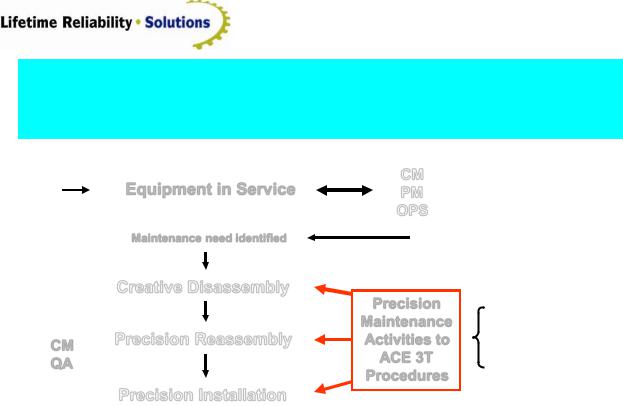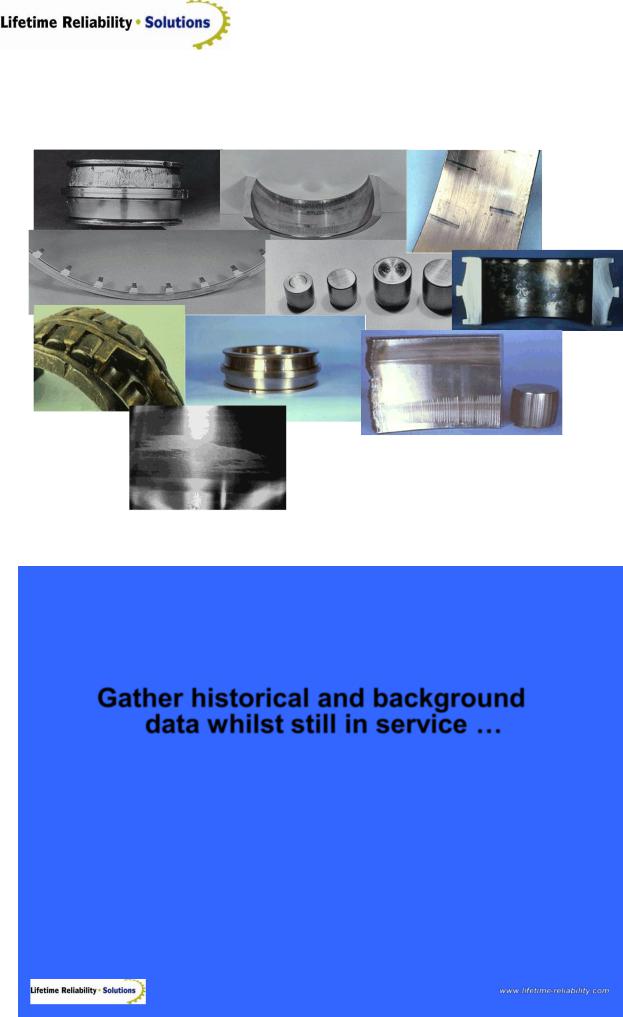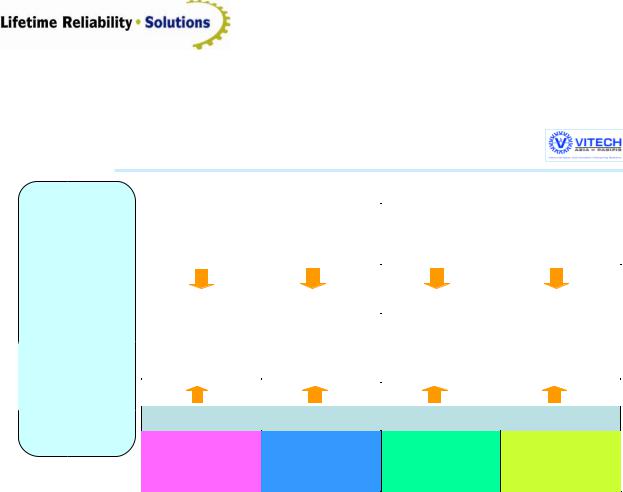
MPS_Day1_World_Class_Reliability_Performance
.pdf
Phone: +61 (0) 402 731 563
Fax: +61 (8) 9457 8642
Email: info@lifetime-reliability.com
Website: www.lifetime-reliability.com
Precision Maintenance is a set of activities performed by the maintenance crew and operators that produce highly reliable machinery. It requires the achievement of very high standards and tolerances, combined with critical observation and assessment skills to identify and remove potential failures.
Introducing Precision Maintenance requires training in best-practice precision skills, supported in the workplace by a top-class engineering ‗body of knowledge‘ including machinery and maintenance standards. If you want equipment in your operation at consistently high reliability, the maintenance and operations people need to develop higher work skills and quality practices that they do not yet have. To develop those skills requires setting high levels of excellence and then training people to them. Many managers, operators and tradespeople will not believe they need such high skills in their operation. This of course is a fundamental error in their thinking. They do not realise that their current processes are not capable of delivering the reliability they want, and explains why many businesses that are busy with improvement efforts still suffer poor availability and breakdowns; they are improving practices that have naturally wide ranges of outcome. Providing tradespeople with a tension wrench to tighten fasteners has little effect on the number of loose and snapped fasteners. If you require tension in fasteners to be accurate to ±10% and provide your people with a process that delivers ±25% variation, there is no chance of consistent success.
The last item in the list of key Precision Maintenance requirements is the glue that keeps the rest together. It requires installing a business process that ensures the other requirements are delivered to every machine and equipment item in the operation. The solution is to use the Accuracy Controlled Enterprise procedural tools to turn precision into standardised procedures. With ACE in place you have the tool to drive amazing equipment reliability and production results. You solve equipment performance problems forever. And, more importantly, it lets you make Precision Maintenance a habit throughout your operation. In a nutshell introducing a Precision Maintenance Program consists of:
•Corporate approval to implement precision maintenance and precision practices
•Agreement across the operation on the plant and equipment to be precision maintained
•Agreement across the operation on the precision standards to use for the plant and equipment
•Agreement across the operation on the best practices to be applied to meet the standards
•Agreement across the operation on the measurement methods that will prove compliance to standards
•Writing ACE 3T procedures for all maintenance and inspection activities on the selected plant and equipment
•Conducting a gap analysis to identify necessary test equipment, specialist tools and facilities
•Identify any needed skills to be learnt by on-the-job training and expert support
•Applying the ACE 3T procedures and refining their use
•Monitoring the effect of the program on plant performance
•Continually improving the use of precision skills and practices
•Expanding the program to other plant, equipment and sites
- 131 -

Phone: +61 (0) 402 731 563
Fax: +61 (8) 9457 8642
Email: info@lifetime-reliability.com
Website: www.lifetime-reliability.com
Standards for World Class Equipment Reliability
„Precise‟
„Smooth‟
„Tight‟
„Dry‟
„Clean‟
„Cool‟
„Repeatable‟
“Only world class standards can produce world class results.”
117
If you want precision maintenance reliability, you will need to bring your peoples‘ machinery skills and engineering knowledge right-up to the level where they can deliver world-class machinery performance. This is what the ACE 3T procedural tool does for you. For Precision Maintenance to work it needs your shopfloor people and maintenance supervision to want it and to learn the necessary new skills. It requires the right engineering know-how and knowledge in the workforce, it requires procedures used in a very specific way to provide statistical quality control of maintenance work. When done properly you will maximise production for little maintenance cost.
Though your shopfloor people deliver Precision Maintenance, it is Maintenance and Operations Managers who start the change, sustain it and keep improving it. The great problem for industry is to find a reliable way to introduce the necessary changes in working practices so that precision thinking becomes the natural way to work. The journey to Precision Maintenance success needs a sound, safe and encouraging method to change the way people work. There needs to be a safe approach for maintainers to gain understanding of Precision Maintenance – its work quality requirements, the skills needed, and the procedural methods to make Precision Maintenance work for the operation.
Starting Precision Maintenance requires a well thought-out and structured change management process that gets your people to want to introduce, and work to, new higher-skilled meticulousness practices.
- 132 -

Phone: +61 (0) 402 731 563
Fax: +61 (8) 9457 8642
Email: info@lifetime-reliability.com
Website: www.lifetime-reliability.com
Using Precision During Maintenance
|
|
|
|
|
|
|
|
CM |
|
CM = Condition Monitoring |
|
|
|
|
|
Equipment in Service |
|
|
PM = Preventive Maintenance |
||||
|
|
|
|
|
PM |
|
|||||
|
|
|
|
|
|
QA = Quality Assurance |
|||||
|
|
|
|
|
|
||||||
|
|
|
|
|
|
|
|
OPS |
|
OPS = Operator Sensing |
|
|
|
|
|
|
|
|
|||||
|
|
|
|
|
|
|
|
|
|||
|
|
|
|
|
|
|
|
|
|
|
(„Watch Keeping‟) |
|
|
|
|
Maintenance need identified |
|
|
|
|
|
ACE = Accuracy Controlled |
|
|
|
|
|
|
|
|
|
|
|||
|
|
|
|
|
|
|
|
|
|
|
Enterprise |
|
|
|
|
|
|
|
|
|
|
|
|
|
|
|
|
|
|
|
|
|
|
|
3T = Target - Tolerance - Test |
|
|
|
|
Creative Disassembly |
|
|
|
|
|
|
|
|
|
|
|
|
|
|
Precision |
These |
|||
|
|
|
|
|
|
|
|||||
|
|
|
|
|
|
|
Maintenance |
techniques |
|||
|
|
|
|
Precision Reassembly |
|
||||||
CM |
|
|
|
Activities to |
deliver |
||||||
|
|
|
|
|
|
ACE 3T |
|||||
QA |
|
|
|
|
|
|
„Machinery |
||||
|
|
|
|
|
Procedures |
||||||
|
|
|
|
|
|
|
Improvement‟ |
||||
|
|
|
|
Precision Installation |
|
|
|
|
|
||
|
|
|
|
|
|
|
|
|
|
||
|
|
|
|
|
|
|
|
|
|
|
|
•Good is not „good enough‟ – excellence is required and expected.
•Most machinery problems are preventable.
119
Precision skills come into play –
•in the disassembly of equipment for maintenance and corrective work. It is when the information is gathered to identify the root causes of failure and to provide feedback information contributing to redesign to eliminate failure and unnecessary maintenance.
•during reassembly and repair of equipment to ensure quality work takes place; attention to fits and tolerances, fitting of bearings and other components etc.
•during installation to ensure foundations and substructures are sound and highest alignment standards are met.
The process of moving Toward Improved Plant Reliability through Precision Skills requires a significant change in attitude and thinking at all levels in the maintenance organisation.
A Change in Philosophy…
FROM detecting problems and fixing them, which is REACTIVE.
TO preventing failures from happening in the first place, which is PROACTIVE.
Good is no longer good enough – excellence is to be expected.
Most machinery problems are preventable.
Everyone in the organization has a role.
- 133 -

Phone: +61 (0) 402 731 563
Fax: +61 (8) 9457 8642
Email: info@lifetime-reliability.com
Website: www.lifetime-reliability.com
Set Standards for Condition and Use of Tools and Equipment
|
A Precision |
Rounded Nuts OK? |
Tool? |
Calibrated?
When?
118
You will even have to go as far as ensuring every tool used in your operation can be trusted whenever it is used. You will need to set standards for the tools your operators and maintainers use so that they do great work every time.
- 134 -

Phone: +61 (0) 402 731 563
Fax: +61 (8) 9457 8642
Email: info@lifetime-reliability.com
Website: www.lifetime-reliability.com
Tell-tale Bearing Failure Signs
Spalling
False Brinelling
Axial Thrust
Fretting Corrosion
Electrical Fluting
Overheating |
Uneven Wear |
|
Smearing |
120
Each of these pictures of failed bearings tell the story of what caused its demise. When bearings are removed look at the ‗story they tell‘ before throwing them into the bin. You will very likely be able to find the cause of the failure and fix it while doing the job.
Creative Disassembly –
Pre-shutdown of Equipment
Gather historical and background data whilst still in service …
•vibration, bearing, thermography, oil data for diagnostic purposes. Look at this for varied process conditions
•check for running „soft-foot‟ (machine distortion
when at operating under load)
• look for resonance in machine, structure, pipe work, other attachments
• look at the equipment‟s maintenance history for tell-tale evidence
|
www.lifetime-reliability.com |
Thanks to Peter Brown of Industrial Training Associates for the slide |
121 |
- 135 -

Phone: +61 (0) 402 731 563
Fax: +61 (8) 9457 8642
Email: info@lifetime-reliability.com
Website: www.lifetime-reliability.com
Improving machinery reliability starts with knowing where its current problems are. That information can be found from the equipment‘s history and by collecting evidence of its poor performance and condition while it is running.
Creative Disassembly –
At Shutdown
Before Strip-down …
•where thermal growth is important for alignment, obtain hot alignment readings while still at operating temperature
•look for witness marks, evidence of shifts or relative movement
•check for static soft foot (machine distortion when at
stand-still)
• sample lubricants and other fluids
|
www.lifetime-reliability.com |
Thanks to Peter Brown of Industrial Training Associates for the slide |
122 |
Creative Disassembly –
At Strip-down
•Look for witness marks, evidence of fretting etc
•Disassemble in clean and well lit areas
•Photograph damage if applicable
•Avoid damaging during removal
•Mark the relative locations of bearings in housings, top and side, inboard and outboard
•Gearing wear patterns - eccentricity, backlash, misalignment etc
Inspection of bearings …
•when removed, prior to cutting
•cut the cage/retainer rather than springing it
•cut outer race from top centre to bottom centre
•re-inspect prior to cleaning
•filter solvents to see what is in the bearing
•analyse bearing and ball path patterns
•spalling patterns revealing poor fitting
•fitted surfaces revealing fretting, out of roundness etc
|
www.lifetime-reliability.com |
Thanks to Peter Brown of Industrial Training Associates for the slide |
123 |
- 136 -

Phone: +61 (0) 402 731 563
Fax: +61 (8) 9457 8642
Email: info@lifetime-reliability.com
Website: www.lifetime-reliability.com
When the equipment is shutdown look for evidence of abnormal operation and condition. As the machine is stripped down look for evidence in its parts and assemblies for signs of what has been happening to it during use. Every part ‗tells‘ us the story of its life, if we look for it.
That‟s how maintainers deliver Precision Maintenance, Ted. We use all of our know-how, expertise and inquisitiveness, along with the necessary technology, to understand what happens to the equipment when it‟s in operation, and then we rebuild it so that it experiences least stresses and degradation when it‟s working.
How do you know that you have done precision work?
As the |
session draws to a close … |
www.lifetime-reliability.com
124
Precision proves itself. First you make sure all the „Tests‟ in the ACE 3T procedures used to strip, rebuild and install were 100% correct. Then as a final check on your workmanship you use condition monitoring to prove the precision standards were met, or bettered.
So first we do quality work, then we use the same equipment that tells us that we have a problem, to tell us we have rebuilt, installed and got the machine running precisely?
Why not? If we have improved our machine we will see it with our condition monitoring in the start-up results.
The results will all be in the „sweet spot‟.
www.lifetime-reliability.com
125
- 137 -

Phone: +61 (0) 402 731 563
Fax: +61 (8) 9457 8642
Email: info@lifetime-reliability.com
Website: www.lifetime-reliability.com
Using Condition Monitoring to
Optimise Availability
Condition monitoring is not only a tool for checking the equipment condition. It is equally as valid to use it to improve the machine conditions.
Life Extension Zone |
Failure Elimination Zone |
|
www.lifetime-reliability.com |
|
126 |
You can use condition monitoring to get higher equipment reliability and higher plant availability. Condition monitoring is a tool to gather the information you need to focus your efforts in increasing reliability. An example is when rebuilding machinery test that the workmanship was to the required standards by checking vibration levels at bearings and making sure they are very low vibration values. Through perseverance you will in time you improve the knowledge and work quality of people, so they learn how to deliver plant and equipment in excellent condition.
- 138 -

Phone: +61 (0) 402 731 563
Fax: +61 (8) 9457 8642
Email: info@lifetime-reliability.com
Website: www.lifetime-reliability.com
A Roadmap for Reliability Improvement
Condition Monitoring Strategy
This is a good |
|
|
Strategies for Reliability Improvement |
||||
|
|
|
|
|
|
|
|
overview of |
|
Specification Review. |
|
Creative Disassembly. |
Lubrication |
Operator training in |
|
what we need |
|
Root Cause Analysis. |
|
Precision |
|||
|
|
Management |
CM and basic |
||||
to do with our |
|
|
|
Maintenance and |
|
|
maintenance routines |
|
|
|
Alignment. |
|
|
||
|
|
|
|
|
|
||
|
|
|
|
|
|
|
|
plant and |
|
|
|
|
|
|
|
|
|
|
|
|
|
|
|
equipment |
|
|
|
|
|
|
|
throughout its |
|
|
|
|
|
|
|
|
The Machine – four essentials for reliability |
||||||
life cycle. If we |
|
||||||
want high |
|
DESIGN |
|
ASSEMBLY |
LUBRICATION |
|
OPERATION |
reliability in |
|
|
Suitability and |
|
Proper sequencing |
||
|
Suitability for purpose. |
|
Machine Assembly |
|
|||
operation we |
|
Suitability for |
|
Machine mounting |
adequacy |
|
and operation |
|
|
Cleanliness |
|
Cleaning |
|||
need to have |
|
environment |
|
Shaft alignment |
|
||
|
|
Sealing |
|
|
|||
|
|
|
|
|
|
||
high reliability |
|
|
|
|
|
|
|
at every stage |
|
|
|
|
|
|
|
|
|
|
Condition Monitoring Methods |
|
|||
of a machine‟s |
|
|
|
|
|||
|
|
|
|
|
|
|
|
life. |
|
|
|
|
|
|
Visual Observations |
|
|
Performance tests |
|
Vibration Analysis |
Oil Analysis |
||
|
|
|
Process control |
||||
|
|
Performance KPI‟s |
|
Thermography |
Wear Debris Analysis |
||
|
|
|
information |
||||
|
|
|
|
|
|
|
|
127
The slide is from Vitech in Australia. It presents a simple and complete approach to increasing machinery reliability. It provides focus and recognises the interconnection between the important factors that affect the equipment life cycle. It indicates the important things that must be done in industrial plants to achieve operating and maintenance excellence that produces world class availability.
- 139 -

Phone: +61 (0) 402 731 563
Fax: +61 (8) 9457 8642
Email: info@lifetime-reliability.com
Website: www.lifetime-reliability.com
Maintenance Management Best Practice –
Profit-Focused, Ultra-High Reliability
Business Value Contribution
Assemble & use a plan for operation, maintenance & improvement of units
Assemble & use a plan for continually removing risk/defects from processes
Z E R O
F A I L
U
R E
Operating Risk
Precision Domain
(with ACE 3Ts)
Optimisation Loop
Life Cycle Profit
Precision
128
Your maintenance methodology and practices need to progress to including the additional stages shown in the slide, if you want to get ultra-high reliability from your plant and equipment. Risk management and Quality Management needs to be woven into everything done in maintenance.
The added boxes are the natural requirements for the progressive businesses of the future. Costs are continually driven-out of the business by people with a passion for mastery over their operating equipment and their duties. They are ‗continual learning and doing‘ experts in their field. They push the limits by using and improving world best practices in risk control and work quality. They monitor how the methodology and practices they use affect the business They support and encourage those approaches that deliver the most value to the business.
This is the world of zero failure!
- 140 -
